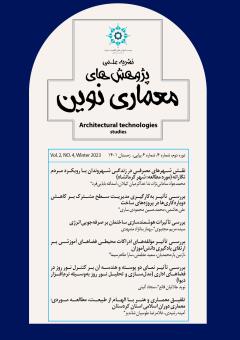بررسی تأثیر نمای دو پوسته و هندسه آن بر کنترل نور روز در فضاهای اداری (مدلسازی و تحلیل نور روز بهوسیله نرمافزار دیوا)
محورهای موضوعی :
نوید جلائیان قانع
1
![]() ,
سجاد آئینی
2
,
سجاد آئینی
2
![]()
1 - دانشجوی دکتری معماری دانشگاه آزاد اسلامی واحد مشهد
2 - دانشآموخته دکتری معماری دانشگاه آزاد اسلامی واحد مشهد.
کلید واژه: هندسه گره ایرانی, پوسته دوم, نور روز, دیوا.,
چکیده مقاله :
نور روز علاوه بر بهينه كردن مصرف انرژی بر كيفيت سلامت فضاهاي داخلي، تقابل معماري با رفتارهاي اجتماعي و سلامت افراد در فضا مؤثر است. استفاده از يك سامانه كنترل نور روز، علاوه بر افزايش كيفيت روشنايي طبيعي فضا، مصرف انرژي الكتريكي ساختمان را بهطور قابل ملاحظهاي كاهش ميدهد. مسئله این پژوهش تلاش برای پاسخ به میزان و نحوه تأثیر کیفیت بازشوهای جدارههای ساختمان بر کیفیت نور روز دریافتی است. به همین جهت به بررسي تأثير میزان بازشو گره ایرانی طراحی شده بر كارايي روشنايي طبيعي در فضاي اداری بر اساس استانداردهای بینالمللی، با استفاده از نرمافزارهاي شبيهسازي نور روز و آناليزهاي سالانه منطبق بر اطلاعات آب و هوايي شهر مشهد، در ساعات اشغال فضا ميپردازد. در گام نخست تلاش شده است تا مفاهیم اساسی پژوهش مورد مطالعه قرار گیرد. در گام دوم با ابزار تحلیلی دست به مورد پژوهی زده شده است و نحوه تأثیر کیفیت بازشوها بر کیفیت دریافت نور مورد واکاوی قرار گرفته است و در گام آخر با استدلال منطقی و مبتنی بر ابزار تحلیلی نتیجه نهایی صورتبندی شده است. نتايج به دست آمده حاكي از آن است كه ضریب بازشو در توزيع روشنايي طبيعي و آسايش بصري در جهتگيريهاي مختلف بهخصوص در جبهه جنوبي تأثير بسیاری دارد. اهمیت نور روز در بهینه کردن مقدار مصرف انرژی، کیفیت سلامت فضاهای داخلی و همینطور تقابل معماری با رفتارهای اجتماعی و سلامت افراد در فضا از طریق طراحی نظاممند که قابلیت کنترل نور روز را با توجه به نیازها و ضروریات فضای زیست داشته باشد مؤثر میگردد.
In addition to optimizing energy consumption, daylight is efficient in the health quality of indoor spaces, the interaction of architecture with social behaviors, and the health of individuals in the space. In addition to increasing the quality of natural light in the space, benefiting a daylight control system significantly reduces the building's electrical energy consumption. The study aims to deals with the amount and the way the quality of the openings of the building's windows affects the quality of the received daylight. Therefore, it investigates the effect of the opening rate of the designed Iranian knot on the efficiency of natural lighting in the office space based on international standards, applying daylight simulation software and annual analyzes consistent with the weather information of Mashhad, through the occupation hours of the space. Firstly, However, the paper studies the basic concepts of the research; secondly, analytical tools are employed and analyzed how the quality of openings affects the quality of receiving light. Lastly, the result is formulated with logical reasoning based on analytical tools. Moreover, the results indicate that the opening coefficient holds a great effect on the distribution of natural light in different directions, particularly on the south front. Furthermore, the importance of daylight in optimizing the amount of energy consumption, the health quality of indoor spaces, and the health of individuals in the space is efficient through a systematic design that may control daylight consistent with the requirements.
